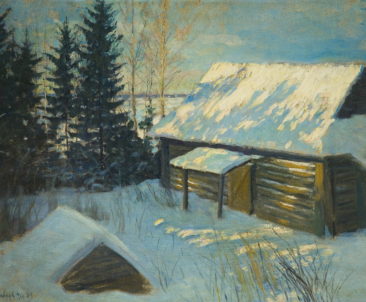

Igor Grabar was born in Budapest in the family of the Russian public figure Emmanuel Grabar. Shortly after the birth of his son, his father and his family were forced to flee Hungary to Italy, and in 1876 his parents, who were among the supporters of the Slavic liberation movement, moved to Russia.
From 1882 to 1989 Grabar studied at the Moscow Lyceum, and from 1889 to 1895 at the St. Petersburg University at once in two faculties – law and history and philology. However, unlike Vladimir’s older brother, who became a famous lawyer, Igor preferred the artist’s career. Even in Moscow, he attended classes in drawing the Moscow Society of Art Lovers and in 1894 entered the Academy of Arts.
The summer of 1895 during the holidays, Grabar travels through Europe, studying the works of old masters. This trip has so captivated the artist that he decides to stay in Europe. However, returning in 1901 to Russia, Igor Grabar was again shocked by the beauty of Russian nature.
In 1910-1923, he moved away from painting and was carried away by architecture, art history, museum activities, the protection of monuments. He conceives and implements the publication of the first “History of Russian Art” in six volumes, writes for it the most important sections, publishes monographs on Valentin Serov and Isaak Levitan. In 1937 he created a two-volume monograph “Repin”. This work brought Grabar Stalin Prize.
Between 1913 and 1925, the artist headed the Tretyakov Gallery. Igor Emmanuilovich is one of the founders of museology, restoration work and protection of monuments of art and antiquity. In 1918 the artist created the Central Restoration Workshop. He helped to save many works of ancient Russian art.
From 1924 to the end of the 1940s Grabar again returned to painting, in the Voronezh Art Museum. I. Kramskoy presents the work of this period – “Winter Day”, 1939. Igor Grabar can truly be considered a singer of Russian winter. In his works, with great love and skill, a radiant whiteness of snow, a special transparent, crystal clear air was transmitted. Snowdrifts shimmer in the sun with all the colors of the rainbow, Valentin Serov noted the skill of Grabar with the words: “It’s a difficult task, but left you,” he told him. “Winter is really white, but you do not feel white.”
Igor Grabar died on May 16, 1960. He was buried in Moscow at the Novodevichy Cemetery.